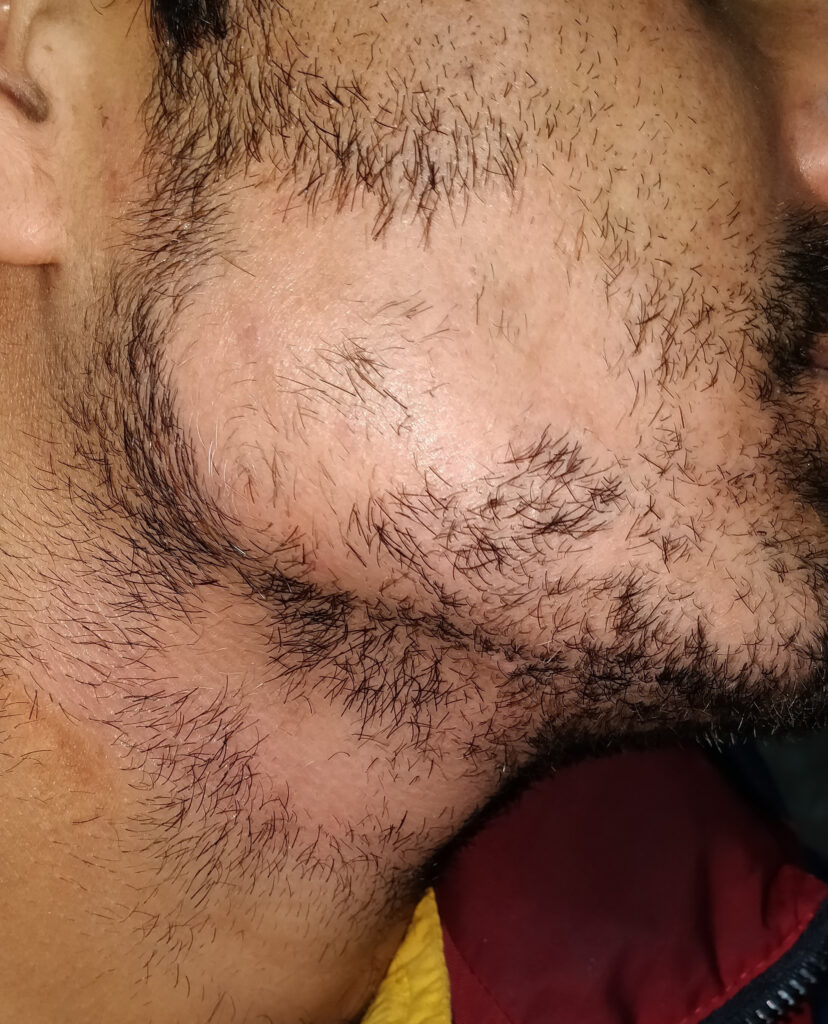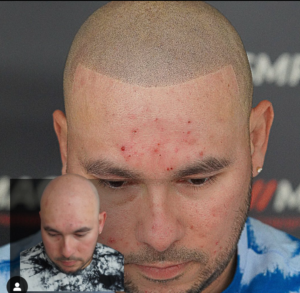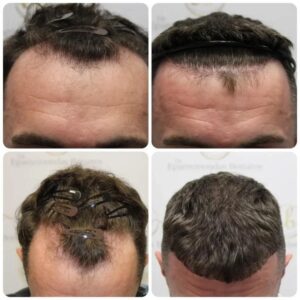A full beard is a symbol of masculinity and power. But for men who suffer from alopecia, the lack of hair on their faces can be a source of insecurity and self-consciousness. This article will take a closer look at alopecia beard (AB) or alopecia barbae – what it is, its causes, and how to get rid of it possibly. If you’re dealing with an alopecia barbae, don’t worry; you’re not alone.
You can feel confident and comfortable in your skin with the right information and careful styling. Keep reading for tips on how to deal with alopecia beard.
Table of Contents
Key Takeaway:
Alopecia beard is a condition that results in hair loss from the beard area. It can affect men of any age but is most common in young men. While the cause of alopecia beard is unknown, it is thought to be related to an underlying autoimmune condition.
There is no cure for alopecia beard, but there are treatments that can help to slow the progression of hair loss. If you are concerned about alopecia barbae, consult a dermatologist or other medical professional for more information.
What is an alopecia beard, and what are the symptoms?
Alopecia beard is a form of alopecia that explicitly affects the hair on your face. It can cause patchy hair loss on your beard, moustache, and even eyebrows. The symptoms of an AB are similar to those of other forms of alopecia—namely, patches of hair loss.
Alopecia beard is an autoimmune disorder. That means that your body’s immune system mistakenly attacks healthy hair follicles. This attack causes the hair follicles to shrink and eventually die. As a result, the hair falls out and is not replaced.
Alopecia beard can occur in men of any age, but it is most common in men over 50. It is also more common in men with a family history of autoimmune disorders.
What causes alopecia beard?
The exact cause of alopecia beard is unknown. However, it is believed to be an autoimmune disorder—meaning your body’s immune system mistakenly attacks healthy hair follicles. This attack causes the hair follicles to shrink and eventually die. As a result, the hair falls out and is not replaced.
Several factors may contribute to the development of an autoimmune disorder, including:
Genetics:
If you have a family history of autoimmune disorders, you’re more likely to develop one.
Environment:
Exposure to certain chemicals or toxins can trigger an autoimmune response.
Infections:
Viral and bacterial infections have been linked to the development of some autoimmune disorders.
Is there a cure for an alopecia beard?
There is no cure for alopecia beard—or any other form of alopecia, for that matter. However, treatments available can help slow down hair loss or even regrow lost hair.
Blood tests can help diagnose alopecia barbae, an autoimmune disease that causes your immune system to start attacking your hair follicles. In some cases, this condition may progress to alopecia totalis, leading to the loss of all your hair.
Exclamation mark hairs may be a telltale sign during a scalp biopsy. It’s essential to differentiate between alopecia barbae and male pattern baldness, as the latter is not an autoimmune condition but a genetic one. Knowing your risk of developing alopecia barbae or other conditions that cause hair loss can help you explore treatments that encourage your hair to grow.
The most common treatment for alopecia beard is immunotherapy. This treatment involves injecting small amounts of a chemical into the bald patches on your face. The chemical helps to stimulate hair growth or hair regrowth.
What are the treatments for alopecia beard?
There is no guaranteed cure for AB. However, some treatment options may help hair regrow or prevent further hair loss.
Minoxidil:
Minoxidil is a topical medication that is available over the counter. It is applied directly to the scalp hair or beard area twice daily. Minoxidil can promote hair growth in men with alopecia beard, but it is not a cure.
Corticosteroids:
Corticosteroids are anti-inflammatory drugs that can be injected into the affected areas of the scalp or beard. They can help reduce inflammation and promote hair growth.
Antibiotics:
If an infection is causing your AB, your doctor may prescribe antibiotics.
Light therapy:
Light therapy, also called phototherapy, involves exposing the skin to certain types of light. This light can help reduce inflammation and promote hair growth. Be sure to check out the possible side effects.
How do I get rid of alopecia on my beard?
If you’re struggling with alopecia on your beard, there are a few things you can do to try and get rid of it.
First, make sure you’re shampooing and conditioning your beard regularly. This will help to keep the hair follicles healthy and prevent them from falling out.
You can also try using a special alopecia beard oil, which can help to stimulate hair growth. Finally, don’t forget to visit your dermatologist for advice. They may be able to recommend a course of treatment to help improve the situation.
With a bit of patience and effort, you should be able to get your alopecia under control and enjoy a healthy, full beard once again.
Will my beard grow back after alopecia?
There is no one answer to this question, as everyone’s hair (and beard) grows at different rates. However, if you are experiencing alopecia, it is essential to consult a dermatologist or other medical professionals to determine the best course of treatment.
In some cases, hair may grow back on its own, while in other cases, medication or surgery may be necessary to promote hair growth.
Coping with Alopecia Beard Emotionally
Dealing with alopecia beard or alopecia barbae goes beyond just understanding the condition and seeking medical treatments. It can be an emotionally challenging journey, and it’s important to address the psychological aspects of hair loss.
Here are some tips to help you cope with alopecia barbae emotionally:
- Self-Acceptance: Understand that alopecia is a medical condition, not a reflection of your character or worth. Embrace the uniqueness it brings to your appearance and personality.
- Seek Support: Don’t go through this journey alone. Reach out to friends, family, or support groups to share your feelings and experiences. Connecting with others who are dealing with alopecia beard can be incredibly comforting.
- Consult a Therapist: If you find yourself struggling with self-esteem issues or anxiety due to alopecia beard, consider speaking with a mental health professional. Therapy can provide you with coping strategies and emotional support.
- Experiment with Different Styles: While treatments can help, it’s essential to explore different beard styles that suit your preferences and personality. Experiment with different lengths, shapes, and grooming techniques to find a style that makes you feel confident.
- Practice Self-Care: Take care of your overall well-being by maintaining a healthy lifestyle. Exercise, eat well, and get enough rest to boost your confidence and overall self-esteem.
- Educational Resources: Continue to educate yourself about alopecia beard and the available treatment options. Understanding your condition and the possible solutions can help alleviate some of the anxiety associated with hair loss.
Remember, you are not defined by your appearance, and there is more to you than your beard. Taking care of your emotional well-being and exploring various styles can help you confidently navigate life with alopecia beard.
Embrace the journey, and don’t let hair loss hold you back from enjoying life to the fullest.
How to style your beard when you have an alopecia beard
There is no right or wrong way to style your beard when you have an alopecia beard. Some men embrace their hair loss and rock an utterly bald look. Others may try to cover up the affected areas with strategically placed facial hair.
If you want to grow your beard, you can do a few things to make the process easier. First, invest in a good beard trimmer. This will help you create a clean, even look.
Second, use beard oil or balm to keep your beard soft and hydrated. Lastly, be patient! It can take time for your beard to grow evenly.
If you want to cover up the affected areas of your beard, there are a few options. You can use makeup to cover up the bald spots. You can also try a fake beard or moustache. Or, you can use a beard transplant to fill in the bald spots.
Conclusion:
So, there you have it. Everything you need to know about Alopecia beard: we hope this article has been helpful and that you now feel more informed about the condition and what can be done to treat it.
If you are a man experiencing hair loss, please don’t hesitate to reach out for help for medical advice – plenty of options are available. And remember, if all else fails, there’s always the hair transplant or beard transplant! Thanks for reading.



